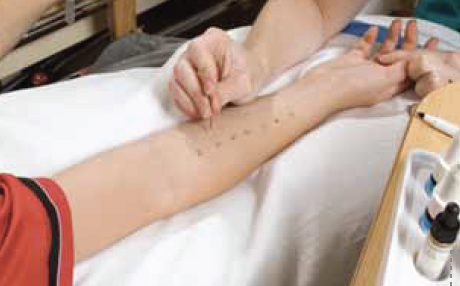Did you know…. that a large number of your hayfever patients may have a
condition known as oral allergy syndrome? In this article we explore what
causes oral allergy syndrome, why it occurs, the symptoms that patients may
suffer and how to manage the problem.
How Can I Assess and Manage Cough in Children?
Children with a cough commonly present to practice nurses. All children cough and often
cough repeatedly, with the majority of episodes associated with self-limiting viral
infections for which there are no effective treatments. Coughing can be highly
distressing for the child and their family members, and can have a significant impact on
a child’s sleep, play and performance in school. Although cough may often be related to
diagnosis of asthma, this is by no means the only cause. The British Thoracic Society recently
published guidelines for the assessment and management of cough in children up to 12 years of
age without known lung disease. Practice nurses and their GP colleagues will find these new
guidelines valuable for diagnosis and management of cough. This article summarises the main
recommendations.
Diagnosing allergy in asthma and allergic rhinitis
Patients with allergic asthma, intermittent (seasonal) or persistent (perennial) allergic
rhinitis, represent a significant proportion of primary care consultations. There is
growing awareness of allergy and the possibility of an allergic component as the cause
of a wide variety of symptoms. It is important to understand how to diagnose atopy to
ensure appropriate management and care of our patients. Diagnosing allergy is initially about
asking the right questions, followed by confirming or refuting the diagnosis by objective testing.
In this article, we explore history taking and objective testing that will help us to manage and
advise patients appropriately.
What are my responsibilities as a practice nurse?
The role of nurses working in the National Health Service has undergone major development
in recent years with new roles and expansion of skills into new areas which has included
respiratory care. However, as always, an increased role demands increased responsibility
and this article examines the key legislation affecting practice nurses, and how they can
reduce the risk of medico-legal action.
Spirometers in primary care: uses and limitations
Modern medical practice emphasises the use of objective measurements and
evidence. Nobody would diagnose hypertension without measuring the blood
pressure, or manage diabetes without measuring blood sugar and glycated
haemoglobin. Yet it is only relatively recently that any lung function
measurements to support diagnosis and guide management of respiratory disease were
undertaken in primary care.
Optimising nutrition in COPD
Although principally an inflammatory respiratory disease, chronic obstructive pulmonary
disease (COPD) is now recognised as a complex disorder that also manifests in
extrapulmonary and systemic effects. Nutritional manifestations of the disease, notably
weight loss and obesity, have been recognised. However, the complexity of nutritional
problems in COPD has been poorly understood, and the consequences largely underrated. Now,
linked to increasing knowledge regarding systemic inflammation, it is becoming clear that poor
nutritional status is not only a manifestation of COPD but also a predictor of mortality and
healthcare utilisation.
How are Patients with Respiratory Disease Treated for Anxiety
As mentioned in the last issue ( Sept 2008), anxiety is a significant and
distressing problem for patients with respiratory disease. Anxiety is more common in
respiratory disease than in cancer, heart failure or other chronic medical conditions
(Kvaal et al 2001). The previous article gave a background to anxiety and highlighted
that practice nurses are in an ideal position to screen for anxiety and to provide appropriate
support and basic treatment. This article focuses on the management of anxiety using cognitive
behavioural therapy skills and techniques.
Cystic Fibrosis: What do we need to know?
Cystic fibrosis (CF) is the most common inherited genetic disease in the UK.
Improvements in both diagnosis and treatment over the last 30 years have resulted in
increased survival with children born in the 1990s now likely to live into their forties.
Although much of the treatment is delivered in hospitals, healthcare professionals in
primary care should be aware of management principles and understand the impact of the
condition on patients and their families. This article provides an overview of CF and shows how
to support patients and families in primary care.
Useful techniques to manage breathlessness
Although breathlessness is a complex symptom, appropriate management in primary
care can be very rewarding, and does not have to rely on complex, hi-tech
interventions. This article discusses the rationale behind the practical interventions
that practitioners in primary care can consider.
Sexual relationships, breathlessness and the respiratory patient
The rising incidence of a range of respiratory disorders means an increasing emphasis
on treatment, management and care. Although some respiratory diseases are acute,
many are chronic, bringing with them a burden of morbidity affecting patients in many
areas of everyday life. One area of concern for patients may be sexual functioning so
somewhere in the process of management and care the practice nurse may need to address the
issues of sexuality (Petty 1986, Kaptein et al. 2008).
Occupational asthma: how to help the wheezy workers
Approximately one in every ten cases of adult-onset asthma is attributable to
occupational exposure. Unless occupation is considered, a diagnosis of occupational
asthma will be missed so it is likely to be underdiagnosed. An average practice with
around 6,000 patients will typically have approximately 600 adult patients with asthma,
of whom 60 may have occupational asthma if we assume 10% of cases are related to
occupational exposure. Can you think of 60 patients with occupational asthma in your practice?
Getting it Right: Asthma Devices in Children
Asthma medications should routinely be delivered by a pressurised metered dose inhaler
(pMDI) and spacer system, with a facemask where necessary, in children under five,
according to the National Institute for Health and Clinical Excellence (NICE).1
For older children, aged 5-15 years, NICE has advised that a child’s therapeutic needs,
the ability to develop and maintain an effective technique, the suitability of a device for the
child’s and carer’s lifestyles (ie portability and convenience) and the likelihood of good
compliance are the factors that should govern the choice of device.2 Only once these factors
have been taken into account, should choice be made on the basis of cost minimisation.

























